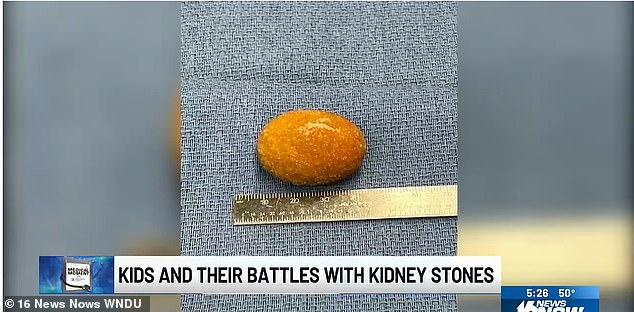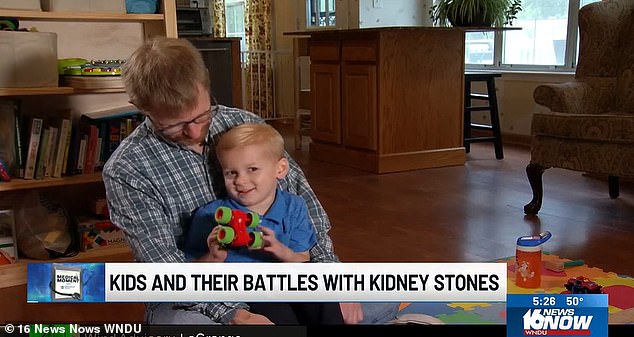Many people think that kidney stones are something that happens to adults, but doctors warn that they are becoming more common in children.
Also known as kidney stone disease, nephrolithiasis or urolithiasis, the problem will affect approximately 11 percent of Americans at some point in their lives.
A kidney stone is a small, hard deposit of minerals and salts that forms in the kidneys.
While most stones are small enough to pass through urine naturally, others, like the ones suffered by four-year-old Alex Zellers, are so large that they must be removed surgically.
While experts can’t point to anything in particular, doctors say that the environment, diets and medications contribute to the increase in kidney stones.
Alex (pictured) has been dealing with painful kidney stones almost his entire life as a result of a genetic disease called cystinuria, which means his body doesn’t absorb certain amino acids.

One stone in Alex’s kidney was the size of a golf ball, while another in his bladder was the size of a lacrosse ball.
Alex has been dealing with painful kidney stones almost his entire life as a result of a genetic disease called cystinuria, which means his body does not absorb certain amino acids.
An amino acid, cystine, then builds up and crystallizes in urine, causing kidney stones to form early in life, said Dr. Greg Tasian, a pediatric urologist at Children’s Hospital of Philadelphia. KABC-TV.
One stone in Alex’s kidney was the size of a golf ball, while another in his bladder was the size of a lacrosse ball. Because his stones were so large, specialists at Children’s Hospital of Philadelphia had to surgically remove them.
“It was like a giant, dense egg… a big mass,” said Alex’s mother, Kate.
Due to his condition, Alex has recurrent urinary tract infections, blood in his urine and has suffered from multiple kidney stones. There is no cure for cystinuria, but it can be controlled with medication.
Cystinuria is responsible for about one percent of all kidney stones, according to NYU Langone Health.

Because Alex’s stones were so large, specialists at Children’s Hospital of Philadelphia had to surgically remove them.
While Alex’s condition is rare, affecting one in every 15,000 people in the U.S., Dr. Tasian said he is seeing a growing number of children with kidney stones overall.
The increase in kidney stones in younger people may be due to children eating more ultra-processed foods, overuse of antibiotics, and warmer temperatures, which can cause dehydration.
High amounts of sodium from processed foods like chips, meats, and sports drinks can lead to extra minerals in your urine that can turn into kidney stones.
Some research has also linked alterations in the gut microbiome (the ecosystem of microbes in the intestines) to the development of kidney stones. Studies imply that the alterations could be caused by excessive use of antibiotics.
Dehydration due to low fluid intake causes more concentrated urine, which can lead to mineral saturation that ultimately forms kidney stones.
“As the world warms due to climate change, the number of stones is expected to increase,” Dr. Tasian said.
Kidney stones are caused by waste products in the blood that form crystals. Over time, the crystals build up to form a hard, stone-like mass.
Once a kidney stone has formed, the body will try to pass it naturally through urine. Most are small enough to do this and can be handled at home.
However, when they grow too large, they can become extremely painful and surgery is usually necessary to remove them.
Common symptoms include abdominal, flank or groin pain, blood in the urine, frequent urination, nausea and vomiting.
Dr. Tasian recommends that people try to drink plenty of water, drink fewer sugary drinks, and reduce salt intake to try to lower the risk of kidney stones.

